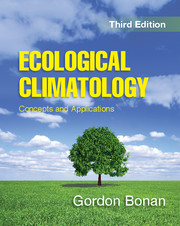1 - Ecosystems and Climate
Published online by Cambridge University Press: 05 November 2015
Summary
Chapter Summary
When viewed from space, Earth is seen as a blue marble. The dominant features of the planet are the blue of the oceans and the white of the clouds traversing the atmosphere. It is an image of fluids – water and air – in motion. Indeed, the study of Earth's climate is dominated by the geophysical principles of fluid dynamics. With closer inspection, however, one can discern land masses – the continents – and the plants that grow on the land. The blue of the oceans gives way to the emerald green of vegetation. Weather, climate, and atmospheric composition have long been known to determine the floristic composition of these plants, their arrangement into communities, and their functioning as ecosystems. Earth system scientists now recognize that the patterns and processes of plant communities and ecosystems not only respond to weather, climate, and atmospheric composition, but also feedback through a variety of physical, chemical, and biological processes to influence the atmosphere. The geoscientific understanding of planet Earth has given way to a new paradigm of biogeosciences. Ecological climatology is an interdisciplinary framework to study the functioning of terrestrial ecosystems in the Earth system through their cycling of energy, water, chemical elements, and trace gases. Changes in terrestrial ecosystems through natural vegetation dynamics and through human uses of land are a key determinate of Earth's climate.
Common Science
Ecology is the study of interactions of organisms among themselves and with their environment. It seeks to understand patterns in nature (e.g., the spatial and temporal distribution of organisms) and the processes governing those patterns. Climatology is the study of the physical state of the atmosphere – its instantaneous state, or weather; its seasonal-to-interannual variability; its long-term average condition, or climate; and how climate changes over time. These two fields of scientific study are distinctly different. Ecology is a discipline within the biological sciences and has as its core the principle of natural selection. Climatology is a discipline within the geophysical sciences based on applied physics and fluid dynamics. Both, however, share a common history.
- Type
- Chapter
- Information
- Ecological ClimatologyConcepts and Applications, pp. 1 - 20Publisher: Cambridge University PressPrint publication year: 2015
References
- 1
- Cited by



